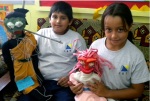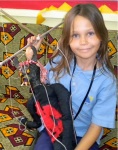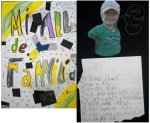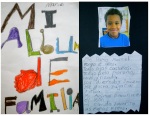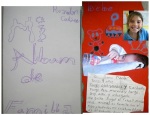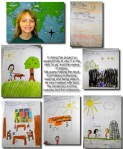Hola! Soy la Sra. Tamara, your child’s Spanish teacher for grades 3, 4 and 5. This blog is to share about your child’s activities In Spanish classes. One of my goals is to integrate technology into the classroom while practicing our listening, writing, reading and speaking skills in Spanish. What better way for you to see how we use technology than to share what we are doing via ‘technology’! This is an opportunity for all of us to see first hand the creativity, culture and wide variety of communication that goes into learning a language. We hope to receive loads of comments and feedback! Beinvenidos
Student Led Conferences – SLC – April 1 and 2
Parents come for student led conferences, SLC. It is a time for your child to share all of their hard work with you. They have created a portfolio to share and in Grade 5, they have A LOT to talk about and show you in Reading, Writing, Mathematics, Science and Social Studies, Word Study and all the specials such as Art, Music, PE and World Language.
You can sign up here: http://www.signupgenius.com/go/5080b48ada823a31-acst
– You simply look for your child’s homeroom teacher, select a time and type in your child’s name or your name – either works.
See you on Weds and Thurs, April 1 and 2.
Mrs. McGuinness and Ms. Tamara
Filed under Uncategorized
Friday, February 13 no school GOOGLE SUMMIT
On Friday, February 13 students will not have classes because we are happy to announce that ACST is hosting its first GOOGLE SUMMIT. You may ask: What is a Google Summit? Well, it is a professional development opportunity for teachers and staff to learn new technology skills. We will have presenters here from 5+ different countries and different international schools. Some of the workshops/presentations offered will be: Building a Professional Learning Network with Google Plus, Using YouTube effectively in the Classroom, Using Google Docs, Google Calendar, & Google Earth, … to name just a few.
Filed under Uncategorized
PTO Discussion about new REPORT CARD format
When: Thursday, January 23, 2014
Where: in the school cafeteria
What: Please come and listen to our elementary principal, Lesley Tait, explain the new format and expectations on the report card. Report cards will be going home on January 31, 2014.
Filed under Uncategorized
SEMANA de IDIOMAS MUNDIALES~World Language Week
el 9 de MAYO hasta el 13 de MAYO
Idioms/Slogans/Tongue Twisters~Expresiones idiomaticas/Dichos/Trabalenguas
Our theme during this week is how language can be used to entertain and share messages that have multiple meanings. We request classroom teachers to invite parents to come into classrooms throughout the week to share stories or examples of how language is used to share messages that have multiple meanings or significances.
el Horario/Schedule/Calendario/Calendar:
lunes/Mon. (May 9) – badges w/ native language greeting – sharing idioms/slogans/tongue twisters in classes for posting on boards around school.
martes/Tues. (May 10) – Kiswahili Day featuring Ngoma Dancers
miercoles/Wed. (May 11) – Spanish Day featuring salsa/guacamole sales &
guest presentation in Spanish room
jueves/Thurs. (May 12) – French Day featuring bake sale
viernes/Fri. (May 13) – Assembly
We invite parents to connect with classroom teachers for any presentations they would like to do during this week in their home languages! las Fotos van a estar pronto!!
Thanks/Gracias/Merci/Asante,
Sra. Tamara
Filed under Uncategorized
Dialogos de Marioneta ~ Puppet Dialogues GRADO 4
These past few weeks in Grado 4 we integrated our language skills with our artistic talent. We made very creative Marionet Puppets in Art class and decided to bring these wonderful Marionetas to life by writing dialogues and recorded them in Spanish, in Spanish class. Many of the personal interview questions that we’ve learned earlier we integrated into the dialogues along with describing their personalities and physical characteristics/parts of the body, special abilities and/or special powers. Many of the Marionetas were based on the Greek Mythological unit that we studied in our Unit of Inquiry. We hope you enjoy viewing them and por favor, feel free to leave unos comentarios!
el Dialogo de Alice y Nuzhhat:
el Dialogo de Nazri, Tahiya y Sahar:
el Dialogo de Kahdija y Sean:
el Dialogo de Tamara-Jo y Kanengo:
el Dialogo de Sonia y Nishant:
el Dialogo de Xandra y Katy:
el Dialogo de Shemei y Cate:
Filed under 4º Grado, Speaking/Hablando, Uncategorized
los AMIGOS de PLUMA ~ PEN PALS en COLORADO Grado 4
- Kadija Y Sean con sus Marionetas
- Nishant y Sonia con sus Marionetas
- Alice y Nuzhhat con su Marioneta
- Xandra con su Marioneta
- Tamara Jo y Kanengo con sus Marionetas
- Nazri, Tahiya y Sahar con sus Marionetas
- Cate y Shemei con sus Marionetas
- el Pizarron de Amigos de Pluma de COLORADO
Filed under 4º Grado, Writing/Escritura
los ALBUMES de FAMILIA de GRADO 3
During the past couple of weeks, el Grado 3 has been practicing and using family vocabulary and descriptions. They created an ALBUM de FAMILIA that included a personal description of themselves and three descriptions of three different family members.
They were very creative and clever in their introductions of their family members.
Some of the ‘frases’ and their meanings were:
Se llama _________ = He/she calls him/herself ___________
Tiene ___ años = He/she is ___ years old (has ___ years)
Tiene ojos _____ (color) = He/she has (color) eyes.
Tiene pelo _____ (color, length, type) = He/she has (type) of hair.
Es ________ y ________ . (descriptions) = He/she is _______ and _______ (descriptions)
Le gusta _________ = He/she likes to _________
and many favorite things such as:
libro favorito = favorite book
película favorita = favorite movie
videojuego favorito = favorite video game
color favorito = favorite color
animal favorito = favorite animal
- Album de Elly
- Album de Eirik
- Album de Tamira
- Album de Charl
- album de KISITO
- Album de Marcel
- Album de Suren
- Album de Talin
- Ablum de Ilsa
- Album de Abby
- Album de Aryan
- Album de Keelan
- Album de Muskan
- Album de Euan
- Album de Daniel
- Album de Lenno
Look forward to seeing their albums come home soon! For more practice on ‘la familia’ and ‘descripciones’ you can select some of the activities on the resources page under Spanish, or go to Sra. Tamara’s Blog de español.
Filed under 3º grado, Writing/Escritura
Grado 5 – LIBROS de LUGARES – el verbo ‘IR’
En el Grado 5 students created LIBROS de LUGARES – Books of Places. The objective of this assignment was (1) to use the verb ‘ir’ ‘to go’ en español and know how the verb changes when using it with a variety of subjects (the people doing the ‘going’ somewhere); (2) to learn and practice vocabulary dealing with places around a city, and/or in a school and (3) to tell someone about where and when, they and their family/friends are going to, to do special activities. After completing their books, students were assessed on the following criteria:
-Aparencia/Legibilidad/Calidad (Appearance/Legibility/Quality
-Gráficas/Dibujos (Graphics/pictures)
-Contenido & Variedad (Content & Variety)
-El uso de Ir + a (Use of the verb Ir, to go + to)
-Creatividad (Creativity)
Students also practiced asking and answering questions using ¿A dónde vas? Where are you going?
You can access the rubric here as a Google document.
We hope you enjoy the Grado 5 collages of their work! Go to Grado 5 for the rest of the LIBROS
- Libro por Antonia
- Libro de Burhannudin
- Libro de Shilen
- Libro de Robyn
Filed under 5º Grado, Speaking/Hablando, Writing/Escritura
las Preguntas y Respuestas (Questions & Answers)
En las Clases de Español (especialmente en los Grados 4 y 5) we are interviewing each other by asking and answering basic questions. We have reviewed/learned that we must raise the tone of our voices when asking questions and that when writing out questions we must use an upside down question mark (¿) in front of the question. You may wonder why this is so! ~ Not all questions in Spanish include a question word (interrogative word) nor is the word ‘do’ used when asking a question as is commonly used in English – this is why we must raise our voices when asking questions in Spanish.
For example:
¿Te gusta jugar al fútbol?
Direct translation is: You like to play soccer/football?
English equivalent is: Do you like to play soccer/football?
We also have been practicing answering questions, both verbally and written, using complete sentences – most answers in Spanish include words from the question in the answer.
For example:
¿Cuál es tu bebida favorita? (Which is your favorite drink?)
Mi bebida favorita es el agua mineral.
Most all of our questions have to do with personal preferences and information about ourselves that we would share when meeting someone for the first time. Other questions are for practicing basic vocabulary.
Our first 20 basic questions we have been practicing are:
¿Cómo se llama Ud.?
¿Dónde vives?
¿Cuántos años tienes?
¿Cómo estás?
¿Qué tal?
¿De dónde eres?
¿Qué te pasa calabaza?
¿Cómo se llama la maestra de español?
¿Qué fecha es hoy?
¿Qué es esto? (point to something you want to know the name of)
¿Cómo se llama el presidente de Tanzania?
¿Cómo se llama el presidente de EEUU?
¿Cuándo es tu cumpleaños?
¿Cuál es tu número de teléfono?
¿Cuál es tu color favorito?
¿Cuál es tu animal favorito?
¿Cuál es tu bebida favorita?
¿Cuál es tu clase favorita?
¿Qué te gusta hacer?
¿Qué te gusta comer?
¿Qué no te gusta hacer?
In order to improve pronunciation and listening comprehension of these questions, Sra. Tamara solicited the help of Sra. Maria Ferres to record interviews with 5 different native Spanish speakers living here in Dar es Salaam. Listen to the following interviews and see if you can understand their answers to the questions … you may use the google.document to fill in the answers as you listen; just click on each name below to listen to their interview.
Una entrevista con Mariano
 Una entrevista con Maria
Una entrevista con Maria
Una entrevista con Lucia
Una entrevista con Guelly
Una entrevista con Catalina
Filed under 4º Grado, 5º Grado, Listening/Escuchando, Speaking/Hablando, Student Learning


